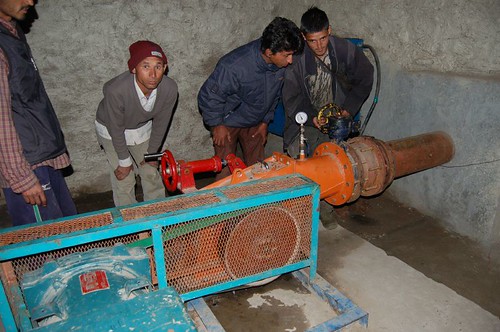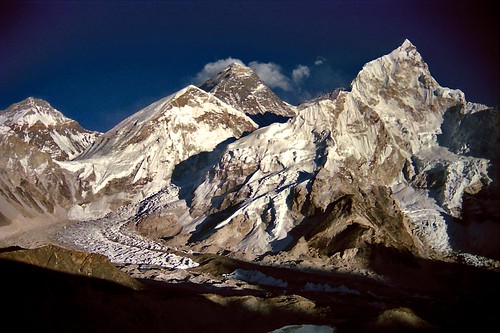Pico Hydro In The Himalaya
Posted by Big Gav in himalayas, nepal, pico hydro, wled
Renewable Energy Access has an interesting article on introducing electricity, on a small scale, into remote Himalayan villages (and if you've ever spent time trekking you'd know this would be a welcome advance out of the middle ages) - A mountain to climb? How pico-hydro helps rural development in the Himalayas.
Example after example of development projects worldwide have shown that local people have to grow into technological and subsequent behavioural changes slowly, for the simple, and perhaps obvious – but rarely admitted – fact that traditions and cultures change much more slowly than new technologies can be introduced. Project planners, in collaboration with local people, have to understand and openly discuss the local cultural milieu, attitudes toward change and the various factors that may predict the ability of each householder to accept and integrate new technologies into their daily lives.
The first time that an electrification system is introduced into a community, a step-by-step approach needs to be taken, starting with minimal, low-level energy services, initially providing indoor lighting only.
Such an approach cuts down on equipment size and weight, saves on infrastructure and transport costs, and increases the chance that local people’s participation will be effective and sustainable. Because the step-by-step approach begins small, it also means that misuse of the system has a relatively small and easily addressed set of consequences. It is much easier to teach people who are not familiar with the basic concepts behind the electrification technology how to use, maintain, and trouble-shoot simple, small systems than large, complex ones. Futhermore, through the participatory planning, building and installation of the rural electricification system with local people, villagers learn new skills and competencies, and develop a strong sense of ownership for the new technology. That allows a more seamless transfer of the project to the local community, which is considerably better prepared and able to run and maintain the system.
Starting small – pico-hydro
The basic village electrification system is a small, embedded power generation unit just sufficient for minimal lighting purposes, utilizing and converting the locally available, renewable energy resources. A typical project is a pico-hydro power plant installed in the village of Kholsi in December 2006. This machine generates 1.1 kW at a maximal water flow of 83 litres/s, with a negative head and a conical draft tube of 2.7 metres long. Working in the pico range means that the chosen lighting technology’s energy demand must be small. Therefore, the ISIS/RIDS-Nepal project, in collaboration with the local Nepali company Pico Power Nepal (PPN), developed white light emitting diode (WLED) lamps, each lamp holding 12 diodes (Nichia NSPW510CSE), with the unit consuming just over 1 W. These lamps are almost unbreakable, and last more than 50,000 hours, some 20 years if used for 7 hours a day.
The entire hydro power plant infrastructure, including the power house and the water canals, are built with locally available materials such as stones and wood, provided by villagers as part of their voluntary contribution to the project. In addition to providing these materials, individuals from every household in the village contributed labour and skilled assistance to the building and installation process.
Buy-in, participation and local sense of ownership were prioritized and openly acknowledged by project participants. While these issues are not a guarantee for long-term sustainability, they are important steps in the direction of a new paradigm of development.
At the completion of the project, villagers were proud of their achievement and described a strong sense of ownership in the entire endeavour. This stood in stark contrast to a hydro scheme several villages to the north, which was conceived of, designed by and implemented by foreign aid workers. Few, if any, local people were involved in a buy-in to the system that could have been achieved by contributing materials or labour of their own accord, nor, according to villagers in that region, were any local people trained on the maintenance of the system. It quickly fell into disrepair.
Kholsi village has 67 homes and one school, each house now has three WLED lamps, while schoolchildren in class read under an additional nine. A total of 210 WLED lamps are supplied.
The generator’s 225 V AC output is transformed to 615 V AC, travels via an armoured underground copper cable to the village, and is again transformed to 225V AC. Upon realizing that householders’ usage of the system for lights consumes a maximum of only 250 W at any time, the system was modified so that 850 W or more can be diverted full-time by a specially developed electronic load controller (ELC) to a water heater. This heats water in a 500 litre plastic tank that is insulated with pine needles and nestles within a larger, 1000 litre plastic tank.
The warm/hot water generated by this system is used for showering, improving hygienic conditions. It can also be used to prepare meals, reducing firewood consumption even more than already reduced by use of efficient smokeless metal stoves also installed in each family home as part of the ‘Family of four’ HCD approach.
From small acorns, mighty oaks
Experience in the field shows that in the context of remote and impoverished mountain villages in Nepal, small power generation systems are on a locally comprehensible, locally sustainable scale, and are therefore highly suitable for such communities, at least as a first step in a rural village electrification process. ...







